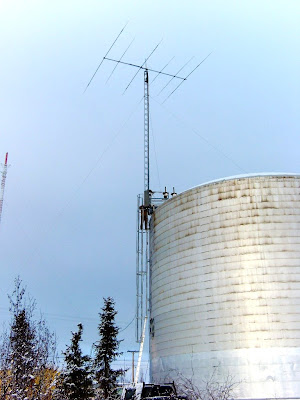I had almost given up even before I started. Back in the spring I started looking around for a station on the island to operate from. A few inquiries were made but by October I still hadn't confirmed anything. Since all available information said it took several months to get a J6 license I was pretty sure my time had run out. I mentioned the situation to Tree, N6TR, during our SS CW operation and within an hour he came up with a couple of contacts for me. Soon I was corresponding with Lionel, J69KZ. His contact at the St. Lucian National Telecommunications Regulatory Commission led me to believe that if I acted quickly there was a chance I could get a license in time for my visit. With that in mind, I downloaded the application forms and had all the required documents couriered to the island.
The licensing process in St. Lucia is somewhat complicated. The main problem is that the process is much the same no matter whether you are applying for a temporary amateur license or a commercial broadcasting license. All applications have to be personally signed by the Minister of Telecommunications and of course they have to negotiate several layers of bureaucracy both before and after they hit the Minister's desk. Fortunately, the islanders are the friendliest people on earth and there was certainly no lack of will on their part to get me licensed in time for the contest. A special thanks, though, is reserved for Bill Schmidt, K9HZ. His detailed information on how to obtain a J6 license was invaluable especially the 'Amazing Race' directions to navigating the several different St. Lucian government offices that have to be visited to complete the final paperwork.
Concurrent with licensing was the issue of finding a place to operate from. The original plan was to operate from Lionel's QTH however this was complicated by the fact that his rental suite was unexpectedly occupied and his family was also in from Canada for the holidays. He suggested that while he'd squeeze me in somewhere if it became necessary, he also had a well-equipped suitcase portable station containing an IC-7000, tuner and power supply, and a G5RV antenna which perhaps I could operate from the resort? I scoped out the resort and found the perfect spot to string up the G5RV from a 4th floor stairwell window over to a convenient tree in the courtyard and our 2nd floor balcony was exactly half way in between. I thought long and hard about how to ask about putting up the antenna. In the end I decided it sounded better to describe it as 'a wire aerial for my radio' instead of a 'hundred foot long ham radio antenna'. I shouldn't have worried. The resort specialized in catering to their guests needs and the best line I heard on the whole trip was 'Are you sure you wouldn't like us to have the maintenance workers put up your antenna for you?' Now that's service!
With the license in hand (it's actually a very official looking 10-page document, printed and bound!) and the G5RV hung in the garden it was time to get on the air. I had never used an Icom IC-7000 before but I knew what I wanted to do so after an hour of flipping through the manual I had the mic gain, ALC and compression set up and programmed the voice memories. I didn't bring a keying interface for the computer and Lionel didn't have a key so I was going to give the CW part of the contest a miss. It wasn't long before I changed my mind. I'm not a big CW operator but the RAC contests (Canada Day and RAC Winter) are two of the few where the exchange is simple and the operators don't seem to feel the need to send CW at 40wpm. On a hunch, I dug a bit deeper into the IC-7000 manual and sure enough, the internal memory keyer had a serial number function. Within a few minutes I had the front panel buttons programmed for the basic exchange information and working VE multipliers on CW was the highlight of the whole contest.
I wanted to do a full 24-hour effort but it didn't work out that way. I got a decent six hour sleep that night and moseyed on down to the buffet table whenever it was required. Propagation wasn't bad but it also wasn't as good as I was expecting given the location and the solar flux. Still, I managed to work all the provinces and only missed VY1, VE8 and VY0. I heard Wally VE8DW with a good signal on 20m right around my sunset but 100 watts and the wire wasn't enough to get his attention. I spent most of the afternoon running on 15m but the rates weren't that high. The biggest Canadian signals in the contest all came from VE6RAC operating from the VE6JY superstation. I heard them on four bands and worked them in both modes on three of them.
The dichotomy of the J6/VE8EV callsign wasn't lost on anyone, especially with the snow and cold spreading across North America. I got lots of comments along the lines of 'I wish I was there' and, not surprisingly given the contest, a lot of 'I wish you were at home'. All in all, I had a ton of fun in the contest but once it was over I was anxious to get back to the sun and surf. I left the antenna up for an extra day and ran a couple of skeds but that was it. Two more weeks and I'll be back to the 40 below zero and 24 hour darkness. I need to soak it all up while I have the chance!

Sunset across the harbour at Gros Islet, St. Lucia.
73 and Happy Holidays
J6/VE8EV


















